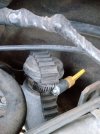Balboa
Member
Hello all,
Months later, I’m still trying to clean up the results of my 4 month visit to Nomadic Vans in Idaho.
I recently finished installing the 3rd alternator after the visit. I’m pretty confident that despite paying them labor, it’s done correctly, now, because I installed this one.
So, to the point of the post. I paid for a basic tune at Nomadic. I’m not really sure what they did, it was supposed to deliver 12 psi boost. They told me that they couldn’t get over 10 psi. It had 10 psi when it arrived.
So, it’s time to tinker. On inspection, tonight, I found the actuator rod very tight, with no retention clip. For reference, I set it slack to have a base line. I found the wastegate barely able to move, it was binding. After a bit of playing around with it, it’s freed up and moves easily. Set slack, it will make 5 psi. My question, are the actuators problematic on the 4D56? It’s probably original. I can’t get any movement from it when off. I expected that I could get some movement manually. What I’m curious to know, is possibly the actuator has failed. I’d like to get that 12 psi if possible.
Thanks for any guidance.
Bill
Months later, I’m still trying to clean up the results of my 4 month visit to Nomadic Vans in Idaho.
I recently finished installing the 3rd alternator after the visit. I’m pretty confident that despite paying them labor, it’s done correctly, now, because I installed this one.
So, to the point of the post. I paid for a basic tune at Nomadic. I’m not really sure what they did, it was supposed to deliver 12 psi boost. They told me that they couldn’t get over 10 psi. It had 10 psi when it arrived.
So, it’s time to tinker. On inspection, tonight, I found the actuator rod very tight, with no retention clip. For reference, I set it slack to have a base line. I found the wastegate barely able to move, it was binding. After a bit of playing around with it, it’s freed up and moves easily. Set slack, it will make 5 psi. My question, are the actuators problematic on the 4D56? It’s probably original. I can’t get any movement from it when off. I expected that I could get some movement manually. What I’m curious to know, is possibly the actuator has failed. I’d like to get that 12 psi if possible.
Thanks for any guidance.
Bill
Last edited:

